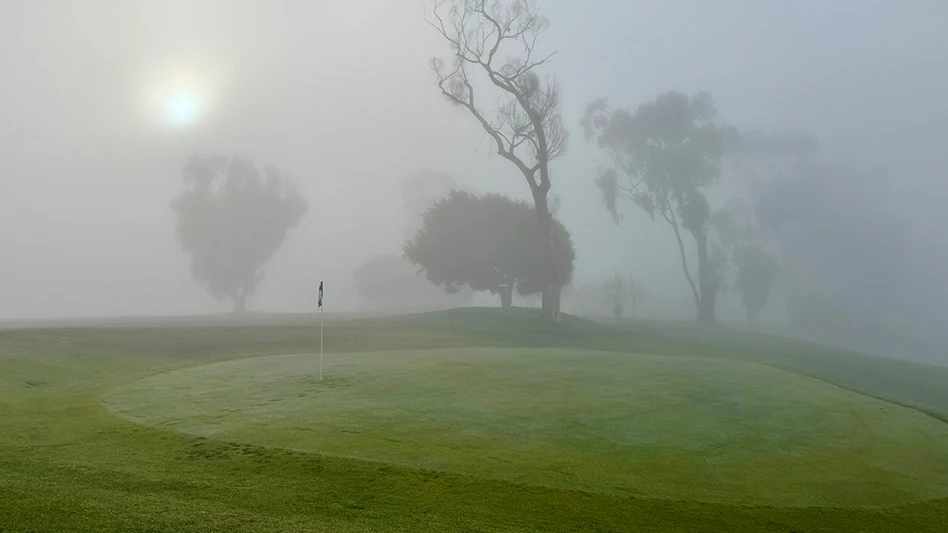The golf business isn’t easy these days. Because of stiff competition and stagnant rounds, management needs to stay on top of course conditions to improve business. As a result, managers of many golf facilities are deciding to renovate the most important areas on their courses – the greens. The 36-hole Kaanapali Golf Course in Maui, Hawaii; 18-hole Butler National in Oakbrook, Ill.; and 27-hole The Village Golf Course in Conroe, Texas, are just a few examples of golf facilities that have regrassed or renovated their greens to retain golfers by meeting their expectations and attract new ones, giving them an edge in competitive markets.
A better playing surface
Kaanapali’s North Course, designed by Robert Trent Jones Sr., opened in 1962, and the South Course, designed by Arthur Jack Snyder, opened in 1974. The resort facility, which averages 90,000 rounds annually, had deferred maintenance under previous ownership; and, as part of that deferred maintenance, there was little or no weed control, says Ed Kageyama, PGA general manager of the Kaanapali Golf Course.
“The weeds were out of control,” he says. “They were everywhere.”
That was the main reason why the new owner – Royal Kaanapali LLC, a private company – decided to renovate the courses.
“We figured that if we had to do all that work, we would improve the overall turf quality,” Kageyama says.
The renovation included a regrassing of all the greens from Tifdwarf Bermudagrass to TifEagle and a renovation of six greens – two on the South Course and four on the North Course. That part of the renovation cost about $2 million, Kageyama says.
Billy Casper Golf, which manages the facility, switched to TifEagle was because other golf courses in the area had success with that turfgrass.
“The playing surface, we felt, was better,” Kageyama says. “It gave a truer roll. There was less grain. It withstands a lower height of cut better, and it has a better look. The old greens were rolling inconsistently.
“When leaning toward selecting TifEagle, we realized the undulations on the greens were too severe for TifEagle, so we softened them a little bit,” he adds. “We didn’t lose character by softening the greens. The playing experiences are better now.”
The North Course greens renovation started in April 2005 and finished in November 2005. Renovation of the South Course started this past April and is scheduled to be completed by November.
To regrass the greens, the sod was cut first, then the greens were treated with methyl bromide. It took a half day to fumigate the greens. Then they were sand-capped and sprigged.
The greens renovation was part of a larger $13-million renovation that included bunkers, tees, cart paths, landscaping and the clubhouse.
“The greens work was the smoothest part of the renovation,” Kageyama says. “The growth of the greens was phenomenal. They came in quickly.”
Kageyama stresses the importance of the condition of the greens, which are the most noticeable and most referenced on the course.
“I’ve always felt golfers can forgive you for tee and fairway conditions, but not greens, so we maintain the highest quality greens possible for the best golfing experience,” he says.
Kageyama says one key to the renovation was golf course superintendent Cal Poouahi, who is an 18-year employee of the facility who worked his way up from an entry-level position.
“His education is his experience on the golf course,” Kageyama says.
Another key to the project was selecting the right contractor. In this case, DHR Construction, which was recommended by the architect who worked on the project – Robin Nelson.
“We heard about DHR through word of mouth,” Kageyama says. “They did a great job executing and working with us and changing on the fly. We were under budget and ahead of schedule and got the intended results.”
More consistency
Designed by George and Tom Fazio, Butler National was built in 1972 and opened in 1974. Home of the Western Open for 17 years and strictly a golf club, it’s considered one of the premier facilities in the Chicago area.
The club’s members are good golfers, and green speed always has been an issue, says Mike Sauls, golf course superintendent at Butler for 16 years. They wanted more consistent green speed.
“We weren’t able to maintain consistent green speeds through the year,” he says. “When there was a lot of hot and humid weather, we had to back off on the double cutting.”
Tom Fazio worked on the greens renovation, and Sauls says the club was privileged to have him involved.
“He was active with the club because it was one of the first golf courses he designed with George,” Sauls says. “Butler had a reputation as one of the toughest courses on the PGA Tour, and it had lost some teeth, so Fazio suggested we renovate.”
Not only did Butler regrass its old Penneagle greens with A-1 bentgrass, it renovated the bunkers and added some tees to stretch the course. The question of rebuilding the greens arose when discussing the renovation, but Sauls felt there was no need to rebuild the greens because the drainage was fine and a renovation would have closed the course for an additional four months, increasing the project cost another $1 million.
The course closed Aug. 15, 2004, and opened Memorial Day weekend 2005. Sauls says there really wasn’t much of a window to do the regrassing because the seed needed to be planted before Labor Day and he didn’t want to cheat on the timing because of Chicago weather.
“Starting in mid-August gave us a two-week buffer zone,” he says.
Sauls says the only question about timing was whether the regrassing should be done all at once or nine holes at a time. He says members wanted it done all at once.
The regrassing was done in-house, and the bunker and tee renovations were done by McDonald & Sons. The regrassing process included:
• Double aerifying the greens;
• Shaving the greens;
• Treating the greens with methyl
bromide;
• Waiting three or four days;
• Vertical mowing the greens;
• Dropping in seed; and
• Watering.
Methyl bromide is being phased out and stockpiles will only last a few more years. Sauls says he doesn’t know what he would use if he had to regrass greens but couldn’t use the fumigant. That factor was one of the reasons he pushed to regrass the greens sooner rather than later. He says some superintendents have used Basamid, but it’s had mixed results. Another option is to use Roundup, but that wouldn’t be good for the Poa seed in the soil.
Sauls says the regrassing process at Butler went smoothly, although he made one mistake. Because the greens are modified sand-based greens with USGA mix up to the surface, the areas above the drain lines dried out, and he was slow to react and hand water those areas, which were set back two weeks.
“They were the only areas in the spring that were thin,” he says.
The big differences between Penneagle and A-1 is A-1’s lack of graininess, Sauls says. It establishes more quickly than Penneagle, and it doesn’t require as much water so he can keep the greens firmer.
After the regrassing, the green speed increased from about 10 to 11 feet on the Stimpmeter, says Sauls, who has a $1-million annual maintenance budget.
“Right now, I haven’t had to back off at all,” he says about mowing the greens.
The cost to regrass the greens was $30,000, not including the revenue lost from when the course was closed. The cost of the overall renovation, which included bunkers and tees, was $2 million.
Sauls says the members were the catalyst for regrassing the greens, and now they’re thrilled with the A-1 bentgrass greens.
“We had two tournaments this summer, and after those two events, we had nothing but raves about the greens,” he says.
Impressing the public
Forty-year-old The Village Golf Course was a private club until two years ago when it became semiprivate. Billy Casper Golf, manager of the property, decided it wanted to regrass the Tifdwarf Bermudagrass greens before the course opened to the public, says golf course superintendent Blake Kercheval. They wanted a selling point and to provide the members a better surface, he says. The old push-up greens consisted of native soil and weren’t sand based.
Improving the soil profile was another reason for renovating the greens, instead of just regrassing them. The green profile was dug out, new drainage installed and the soil was replaced with 12 inches of USGA-specified sand. It took two weeks to pack down the sand to get the final profile, Kercheval says. The actual greens renovation took eight weeks, and then after the California-style greens were sprigged with MiniVerde Bermudagrass, there was a 10-week grown-in period before the greens were playable.
Nine holes were done at a time, but only 18 of 27 greens were renovated. It took one year for each nine holes.
Kercheval, who started just after the first nine was regrassed, came from a course that did the same thing, he says. The decision to use MiniVerde was made before Kercheval arrived, and he says TifEagle wasn’t chosen because it’s older than MiniVerde and is more susceptible to disease pressure.
“That was the feedback from those who had managed both turfgrasses,” he says. “I don’t use as much fungicide with MiniVerde compared to TifEagle. MiniVerde is a very aggressive grass that has good recovery. If you manage water right, the hot spots recover quickly.”
After the greens grew in, Kercheval didn’t overseed and says the MiniVerde lost color for only one week during the winter. He also says there’s not as much thatch build-up compared to TifEagle.
“The surface is better because it gets a truer roll,” he says.
It’s been two and a half years since the first nine was renovated and a year and a half since the second nine was done. Kercheval says the main difference between the two renovated nines is there’s more moisture retention in the greens that were renovated first because there’s more organic matter build-up.
Renovating the last nine isn’t in the immediate future, but the plans are there, says Kercheval, who has a annual maintenance budget of $575,000.
Looking back on the renovation, Kercheval says he would have used soil amendments in the project to help with water retention, but says he wasn’t involved in those discussions. Water retention was the only issue – finding hot spots and knowing how to treat them with wetting agents.
Switcheroo
Kercheval says many courses with warm-season turfgrass want to change to an ultradwarf Bermudagrass because of player demand. Additionally, not overseeding is the “in” thing. But ultimately, competition is driving most courses to change their greens.
Regrassing or renovating greens is driven by membership these days. In the Chicago area, there are still a lot of Poa annua greens, and some of the Poa dies in hot, humid weather with heat indexes in the 110 range, Sauls says, adding that the new bentgrasses are much better than the old ones.
“They’re seeing other clubs switch to the newer bentgrasses, and they want to follow,” he says. GCN

Explore the September 2006 Issue
Check out more from this issue and find your next story to read.
Latest from Golf Course Industry
- Beyond the Page 65: New faces on the back page
- From the publisher’s pen: New? No way!
- Indiana course upgrades range with synthetic ‘bunkers’
- Monterey Peninsula CC Shore Course renovation almost finished
- KemperSports and Touchstone Golf announce partnership
- PBI-Gordon Company hires marketing manager Jared Hoyle
- Mountain Sky Guest Ranch announces bunker enhancement project
- GCSAA names Joshua Tapp director of environmental programs





